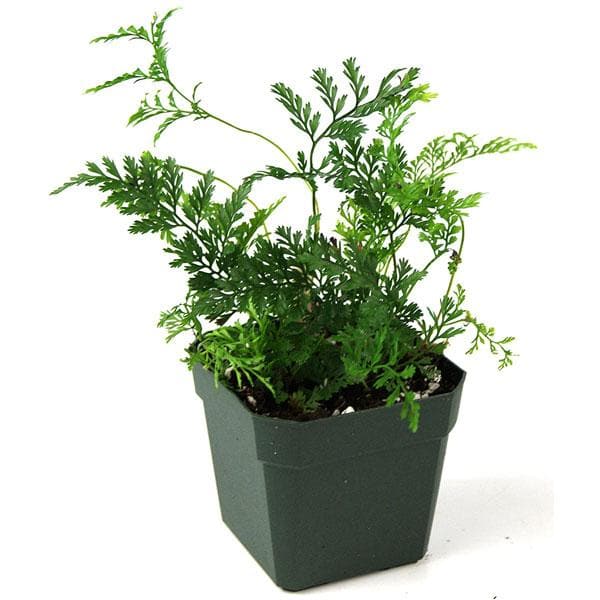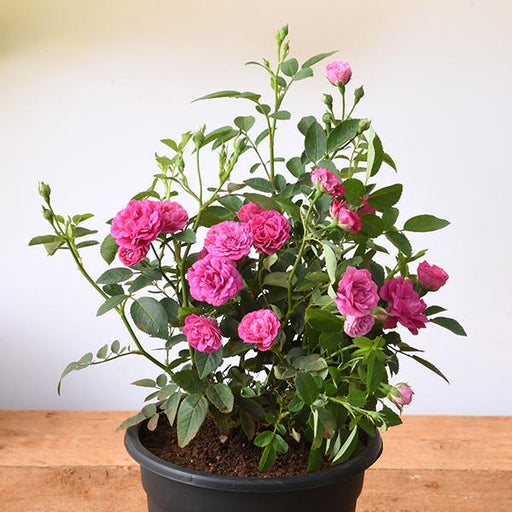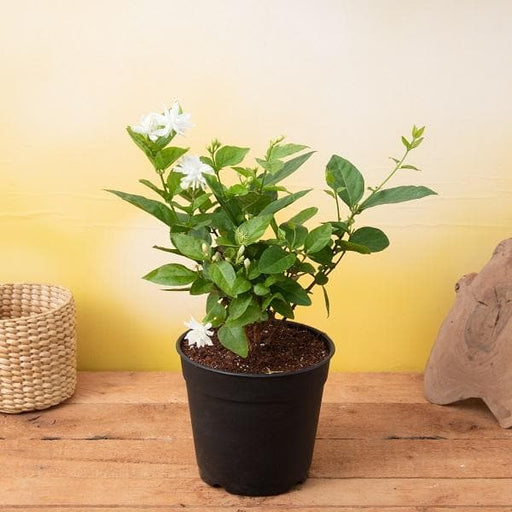
Davallia Trichomanoides, Small Rabbit Foot Fern - Plant
(MRP Inclusive of all taxes)
- Shipping ₹79 for entire order
- Dispatch in 7 days
- Country of origin: India

(MRP Inclusive of all taxes)
 Save 29%
Save 29%
Air Purifier Money Plant with Pot The Air Purifier Money Plant, also known as Pothos or Epipremnum aureum, is a stunning indoor plant that...
View full details
 Save up to 15%
Save up to 15%
Peace Lily, Spathiphyllum - Plant The Peace Lily, scientifically known as Spathiphyllum, is a stunning houseplant celebrated for its elegant white...
View full details
 Save 25%
Save 25%
Jasminum sambac, Mogra, Arabian Jasmine - Plant Jasminum sambac, commonly known as Mogra or Arabian Jasmine, is a fragrant flowering plant...
View full details
 Save 18%
Save 18%
Combo Constituents Includes the Parijat Tree (Night-Flowering Jasmine), a culturally significant plant with fragrant flowers. Description The Pari...
View full details
 Save 25%
Save 25%
Miniature Rose, Button Rose (Any Color) - Plant The Miniature Rose, also known as the Button Rose, is a charming and compact flowering plant that ...
View full details Save 25%
Save 25%
Damascus Rose, Scented Rose (Any Color) - Plant The Damascus Rose, also known as Rosa damascena, is a timeless symbol of beauty and romanc...
View full details
 Save 17%
Save 17%
Beautiful Fragrant Mogra, Arabian Jasmine Plant with Pot The Beautiful Fragrant Mogra, also known as Arabian Jasmine (Jasminum sambac), is...
View full details Save 15%
Save 15%
Pack of Vermicompost and Neem Cake for House Plants Transform your indoor garden with our premium Pack of Vermicompost and Neem Cake, spec...
View full details
Pack of Plant Growth and Flower Boosters Unlock the full potential of your garden with our Pack of Plant Growth and Flower Boosters! This ...
View full details Save 38%
Save 38%
Combo of Jeevamrut and Neem Raksha for Easy Growth and Protection of Houseplants Transform your indoor garden with our exclusive combo of ...
View full details Save 22%
Save 22%
Plant Nutrients Kit (Pack of 16) for a Healthy Garden Transform your garden into a lush paradise with our Plant Nutrients Kit, featuring 1...
View full details Save 16%
Save 16%
Combo of Top Plant Fertilizers Elevate your gardening game with our exclusive Combo of Top Plant Fertilizers, featuring two bags of premiu...
View full details Save 24%
Save 24%
Pack of 4 Additives to Make Soil Healthy and Nutrient Rich Transform your garden into a thriving ecosystem with our Pack of 4 Additives de...
View full details Save 30%
Save 30%
Transform your gardening experience with our premium Combo of Perlite and Vermiculite. This unique blend is designed to enhance soil aeration and ...
View full details Save 27%
Save 27%
Combo of 2 Vermicompost and Cocopeat - Enrich Your Soil Naturally! Transform your garden into a thriving ecosystem with our Combo of 2 Ver...
View full details
 Save 35%
Save 35%
Best 6 Plants for Perfect Indoor Garden Transform your living space into a lush oasis with our curated collection of the Best 6 Plants for a...
View full details
 Save up to 50%
Save up to 50%
Mini Succulent Garden Pack Transform your space with our Mini Succulent Garden Pack, featuring a delightful collection of 4 any variety beautiful s...
View full details
 Save 30%
Save 30%
5 Best Fragrant Plants Transform your garden or indoor space into a fragrant paradise with our curated selection of the 5 Best Fragrant Plants. Th...
View full details
 Save 24%
Save 24%
Set of 2 Bonsai Looking Grafted Adeniums Transform your indoor or outdoor space with our exquisite Set of 2 Bonsai Looking Grafted Adenium...
View full details Save 45%
Save 45%
Top 4 Die Hard Succulents Pack Transform your indoor or outdoor space with our Top 4 Die Hard Succulents Pack, featuring a curated selecti...
View full details
 Save 30%
Save 30%
5 Best Indoor Plants Pack Transform your living space into a lush oasis with our '5 Best Indoor Plants Pack.' This carefully curated collection fe...
View full details
 Save 25%
Save 25%
Set of 4 Evergreen Air Purifier Plant Pack Transform your indoor space into a lush, green oasis with our Set of 4 Evergreen Air Purifier Pla...
View full details| SrNo | Item Name | Qty |
|---|---|---|
| 1 | Davallia Trichomanoides, Small Rabbit Foot Fern Plant in 4 inch (10 cm) Pot | 1 |
The Davallia Trichomanoides, commonly known as the Small Rabbit Foot Fern, is a captivating houseplant that brings a touch of the wild into your home. With its unique, furry rhizomes resembling rabbit feet, this fern is not only visually appealing but also easy to care for. Native to tropical regions, it thrives in humidity and adds a lush, green aesthetic to any indoor space.
What makes the Small Rabbit Foot Fern special is its adaptability and resilience. This fern can flourish in low light conditions, making it an ideal choice for beginners and seasoned plant enthusiasts alike. Its distinctive foliage and charming growth habit make it a conversation starter and a delightful addition to any plant collection.
Special features of the Davallia Trichomanoides include its ability to purify the air, contributing to a healthier indoor environment. Additionally, its unique growth pattern allows it to cascade beautifully over the edges of pots, creating a stunning visual effect that enhances any decor.
If you think caring for a plant is as easy as watering it and giving it a pep talk, think again! The Small Rabbit Foot Fern requires a bit more finesse. This fern thrives in indirect light and loves humidity, so if you live in a desert, you might want to invest in a humidifier. Keep the soil moist but not soggy, and watch out for those pesky pests. Treat it like royalty, and it will reward you with lush, green fronds that will make your friends green with envy.
Who knew that a plant could be your new best friend? The Rabbit Foot Fern not only adds a touch of greenery to your space but also purifies the air. It’s like having a tiny, leafy superhero in your home, fighting off toxins while looking fabulous. Plus, it’s pet-friendly, so your furry companions can frolic around without fear of a botanical disaster.
If you’re looking to bring the outdoors in, indoor ferns are the way to go. They’re like the cool kids of the plant world, effortlessly stylish and low-maintenance. The Davallia Trichomanoides is a standout, with its unique fuzzy rhizomes resembling rabbit feet. These ferns thrive in low light and add a lush vibe to any room. Just remember, they prefer a little humidity, so don’t forget to mist them occasionally.
New to the plant parent game? Fear not! The Small Rabbit Foot Fern is the perfect starter plant. It’s forgiving, low-maintenance, and doesn’t require a degree in botany to keep alive. Just give it some indirect light, a sprinkle of water, and a little love, and you’ll be on your way to becoming a proud fern parent. Plus, it’s a great conversation starter—everyone will want to know about your “rabbit foot” plant!
If your home is more cave than rainforest, fear not! The Davallia Trichomanoides thrives in low-light conditions, making it the perfect companion for those dimly lit corners. It’s like the introvert of the plant world, perfectly content in the shadows while still looking fabulous. Just remember to keep it away from direct sunlight, or it might throw a tantrum and turn crispy.
Tired of the same old snake plants and pothos? The Small Rabbit Foot Fern is here to shake things up! With its quirky rhizomes and lush fronds, it’s a conversation piece that will have your guests asking, “What on earth is that?” It’s the perfect blend of unique and easy-going, making it a must-have for any plant enthusiast looking to add a little flair to their collection.
If you want your Davallia Trichomanoides to thrive, you’ll need to embrace the humidity! These ferns are like tropical vacationers, loving the moist air and feeling right at home in a steamy bathroom or kitchen. If your home is drier than a desert, consider investing in a humidifier or misting your fern regularly. Your plant will thank you with vibrant growth and lush foliage.
Want to expand your fern family? Propagating the Small Rabbit Foot Fern is easier than you think! Simply take a healthy rhizome and plant it in a new pot with fresh soil. Keep it moist and in a warm spot, and soon you’ll have a mini fern army ready to take over your home. It’s like cloning, but way less sci-fi and way more green!
If you’re a fan of mini ecosystems, the Davallia Trichomanoides is a fantastic addition to your terrarium. Its compact size and love for humidity make it a perfect fit for those glass wonders. Just remember to provide adequate drainage and keep the environment moist. Your little fern will thrive in its glass palace, and you’ll have a stunning centerpiece that’s sure to impress.
In the battle of the ferns, the Small Rabbit Foot Fern stands out with its unique appearance and easy-going nature. While other ferns may require more light or specific care, this little gem is adaptable and forgiving. It’s like the laid-back friend who can hang out anywhere and still have a good time. So, if you’re looking for a fern that won’t stress you out, this is your winner!
Caring for indoor plants can feel like a full-time job, but the Davallia Trichomanoides makes it a breeze. With its low-maintenance needs and forgiving nature, it’s perfect for those who want greenery without the hassle. Just a little water, some indirect light, and a sprinkle of love, and you’ll have a thriving fern that adds life to your space without demanding too much attention.
Looking for a natural air purifier? The Small Rabbit Foot Fern is here to save the day! Not only does it look fabulous, but it also works hard to filter out toxins and improve your indoor air quality. It’s like having a tiny environmentalist in your home, quietly doing its part to keep the air fresh and clean. So, while you’re busy living your life, let this fern handle the dirty work!
This charming little fern, also known as the Small Rabbit Foot Fern, is a delightful houseplant with fuzzy rhizomes resembling rabbit feet. It thrives in humidity and indirect light, making it a perfect companion for your indoor jungle. Just don’t expect it to hop around; it prefers to stay rooted!
Caring for this fern is a breeze! Keep it in bright, indirect light and maintain humidity levels. Water it when the top inch of soil feels dry, but avoid soggy feet—err, roots! A little misting goes a long way in keeping those fuzzy rhizomes happy and healthy.
Absolutely, but only in suitable climates! If you live in a warm, humid area, feel free to let your Small Rabbit Foot Fern bask in the great outdoors. Just remember to provide some shade and protection from harsh winds. Otherwise, it might just hop back inside!
This fern loves a well-draining potting mix that retains some moisture. A blend of peat, perlite, and orchid bark works wonders. Think of it as a cozy bed for your fern—snug enough to keep it comfy but airy enough to prevent root rot.
Watering depends on your environment, but generally, once a week should do the trick. Just check the top inch of soil; if it’s dry, it’s time for a drink. Remember, this fern prefers to sip, not chug, so avoid drowning it!
Yes, but don’t overdo it! Feed your Small Rabbit Foot Fern with a diluted liquid fertilizer every 4-6 weeks during the growing season. Think of it as a little pick-me-up, but don’t let it get too spoiled—too much fertilizer can lead to a fern that’s more sassy than classy!
Good news for pet parents! The Small Rabbit Foot Fern is non-toxic to cats and dogs. So, you can let your furry friends roam freely without worrying about them nibbling on your leafy companion. Just keep an eye on them; curiosity can lead to mischief!
Keep an eye out for pesky critters like spider mites and mealybugs. If you spot them, don’t panic! A gentle wipe with a damp cloth or a spray of insecticidal soap can send them packing. Your fern deserves a pest-free life, after all!
Yes, you can! Propagation is as easy as pie. Simply take a healthy rhizome and plant it in moist soil. With a little patience and care, you’ll have new ferns hopping around in no time. Just remember, sharing is caring, but don’t go overboard!
This fern is a fan of mild temperatures, ideally between 60°F to 75°F. It’s not a fan of extreme heat or cold, so keep it away from drafts and heaters. Think of it as your fern’s Goldilocks zone—just right for happy, healthy growth!
A healthy Davallia Trichomanoides boasts vibrant green fronds and fuzzy rhizomes. If the leaves start to yellow or brown, it might be time to reassess your care routine. Keep an eye out for droopy fronds; they’re like little fern SOS signals begging for attention!